Key takeaways:
- Tech events foster collaboration and idea exchange among diverse participants, but can also present challenges due to difficult attendees, such as “Know-it-Alls” and “Disruptors.”
- Effective management strategies include proactive communication, setting clear expectations, and utilizing technology like real-time polling to engage attendees.
- Addressing conflicts thoughtfully, such as acknowledging frustrations and inviting quieter voices to participate, can transform potentially negative situations into positive dialogues.
- Investing in skilled facilitators and gathering pre-event feedback can enhance attendee experience and ensure smoother interactions throughout the event.
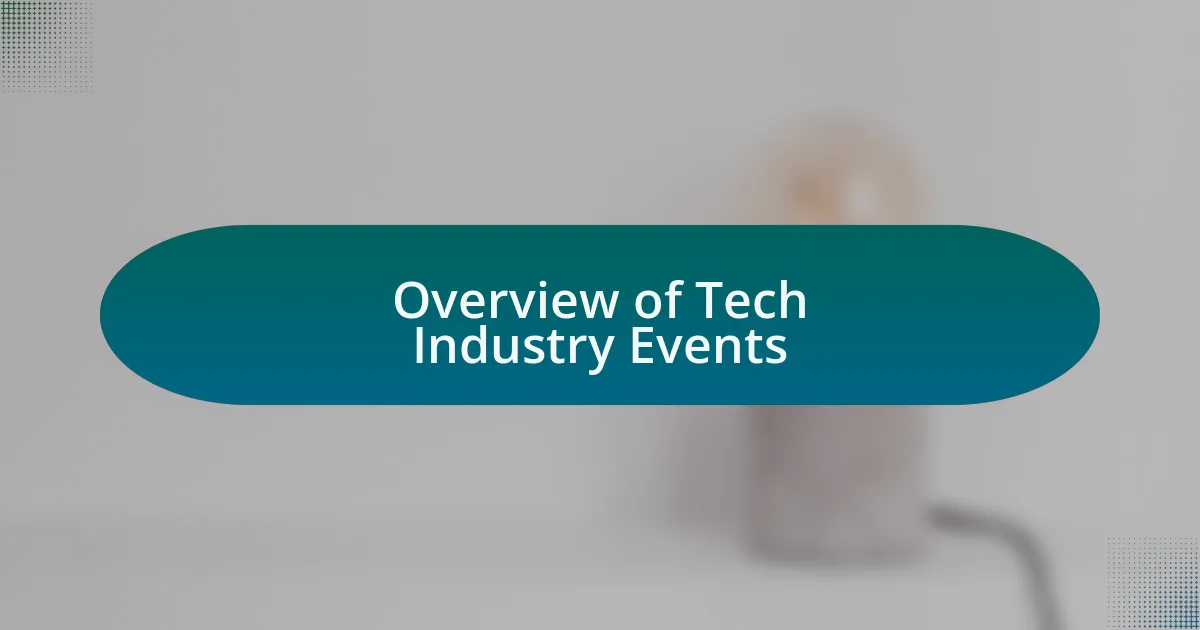
Overview of Tech Industry Events
Tech industry events are designed to bring innovators and industry leaders together, sparking collaboration and idea exchange. I’ve attended numerous conventions where the energy is palpable; you can almost feel the excitement in the air as people gather to share their latest breakthroughs. Isn’t it fascinating how a single event can lead to partnerships that change the course of a company’s future?
These gatherings often include a mix of keynotes, breakout sessions, and networking opportunities, creating a dynamic environment. I remember sitting in a workshop where an unexpected question from the audience led to a lively debate, shedding light on perspectives I had never considered. Isn’t that the beauty of these events? They provide a platform for diverse voices to contribute, challenging our preconceived notions.
Moreover, the sheer variety of attendees—from fledgling startups to well-established tech giants—adds layers of complexity to the atmosphere. After all, each participant brings their own hopes, experiences, and sometimes, expectations that don’t align with reality. Have you ever witnessed a conversation shift drastically when someone expresses an opinion that clashes with the prevailing sentiment? It reminds us that every event is not just about technology but also about the human interactions that drive the industry forward.
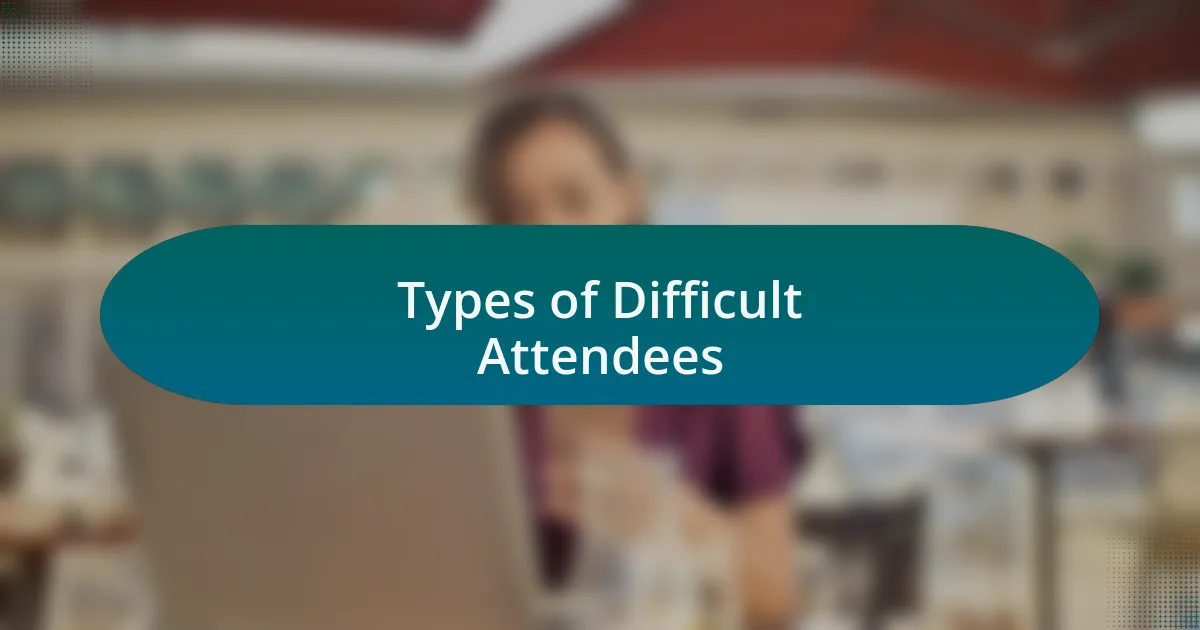
Types of Difficult Attendees
Dealing with challenging attendees can be a common hurdle at tech events, and I’ve encountered several distinct types. One particularly memorable example is the “Know-it-All,” who insists on dominating conversations with their opinions and dismisses others without a second thought. I once found myself in a discussion where this individual overshadowed valuable insights from quieter team members, leaving the room feeling frustrated. It’s curious how a single voice can dim the enthusiasm of the whole group.
Another type that often emerges is the “Disruptor,” someone who thrives on challenging authority and can derail meetings with controversial points. At one conference, I witnessed a passionate outburst from a Disruptor questioning a speaker’s credentials. While it added an unexpected twist to the dialogue, it also created tension that the moderator had to quickly diffuse. Have you ever noticed how these disruptions can sometimes spark deeper conversations, even if they rattle the initial agenda?
Lastly, we can’t overlook the “Disengaged Attendee,” the person sitting quietly, scrolling through their phone or zoning out entirely. I recall a session filled with engaging discussions where a couple of attendees seemed completely detached. It made me wonder: what are we doing as organizers to capture their attention? Tackling these types requires a keen awareness of group dynamics and the ability to adapt on the fly, ensuring that everyone feels valued and included in the experience.
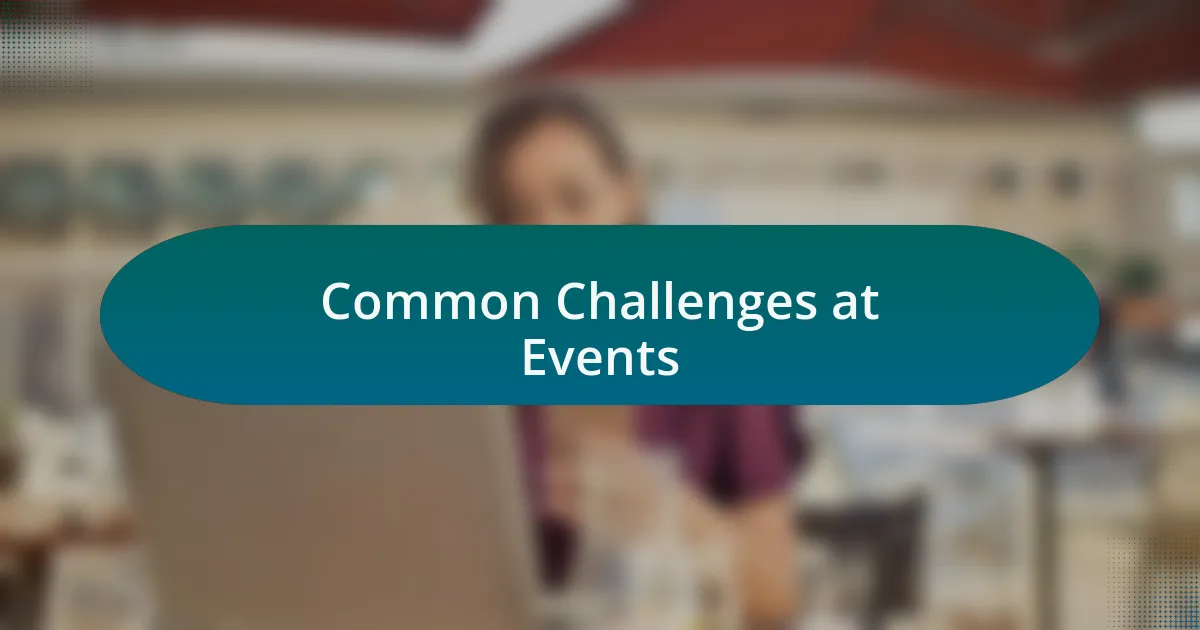
Common Challenges at Events
One common challenge I’ve encountered at events is managing the “Overly Critical Attendee.” I remember sitting in a workshop where one individual seemed determined to find fault in everything from the presentation style to the content itself. It was disheartening to see how their negativity affected the atmosphere, leaving others hesitant to share their thoughts. How can we encourage constructive feedback without letting criticism overshadow the positive aspects?
Another frequent issue is the “Time-Occupying Attendee,” who monopolizes the Q&A sessions. I once experienced this at an industry panel where one person asked multiple lengthy questions, leaving very little time for others. It highlighted the importance of setting clear guidelines for participation. I’ve learned that establishing time limits not only helps manage the flow but also ensures that diverse voices have the chance to contribute.
Lastly, there’s the challenge of the “Distracted Attendee,” who might be physically present but mentally somewhere else. I recall a session where many were preoccupied withtheir devices, missing out on valuable information. This made me think about our responsibility as speakers and organizers: how can we create captivating experiences that command attention? Engaging formats, interactive discussions, and vibrant visuals can go a long way in capturing and holding the audience’s focus.
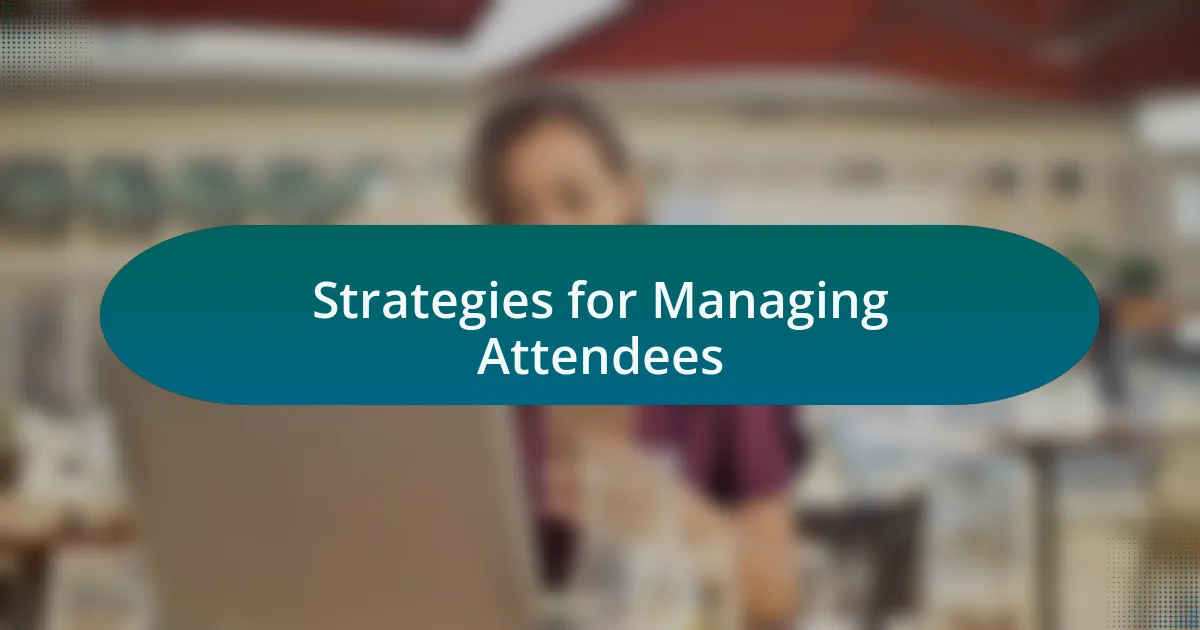
Strategies for Managing Attendees
To effectively manage difficult attendees, I’ve found that proactive communication can be a game changer. During a recent event, I implemented a system of clear expectations shared right at the beginning. By outlining how Q&A sessions would work, we came up with a straightforward rule: a maximum of two questions per person. It not only kept the flow steady but also encouraged others to participate without feeling overshadowed.
Creating a supportive environment is crucial, especially when addressing feedback from critical attendees. I recall a challenging session where I approached the critical individual personally afterward, thanking them for their input and inviting them to share their views in a one-on-one conversation. This not only diffused the situation but turned what could have been a negative experience into an opportunity for a more constructive dialogue. Have you ever thought about how addressing concerns directly can turn antagonism into collaboration?
Utilizing technology can also be a powerful strategy. At my last conference, we employed real-time polling to address the distractions that come up when attendees are fiddling with their devices. I noticed that when participants could engage through their phones, answering quick polls during sessions, it captured their attention and made them feel involved. It prompted me to wonder: what innovative tools could we introduce next to keep our audience engaged and make them part of the conversation?
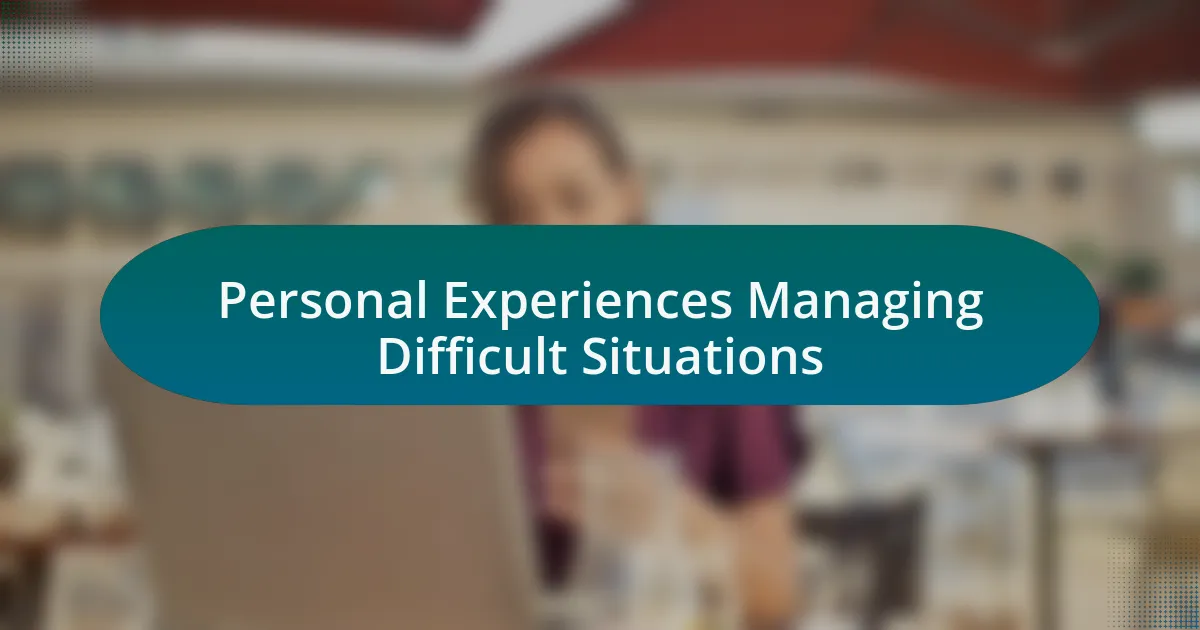
Personal Experiences Managing Difficult Situations
Managing difficult situations at events has always been a learning experience for me. I remember one occasion when a participant became frustrated during a panel discussion. Instead of dismissing their outburst, I took a moment to listen. This approach not only calmed them down but also garnered respect from the rest of the audience, leading to a more open dialogue. Isn’t it fascinating how sometimes simply acknowledging someone’s feelings can transform the atmosphere?
Another situation that sticks with me involved an attendee who challenged our keynote speaker aggressively. Rather than letting the tension escalate, I chose to intervene with a light-hearted comment that redirected the conversation. This defused the energy and helped everyone refocus on the content of the talk. It made me realize that humor can be an effective tool in managing heated discussions—have you ever considered how a well-placed joke can change the dynamics of a room?
At a tech conference last year, I faced a particularly combative attendee who consistently interrupted others. I decided to address the behavior not just in the moment but also later with them privately. I expressed my gratitude for their passion while gently reminding them of the impact on others. This conversation not only improved their future interactions but also taught me a valuable lesson about balancing firmness with empathy. How often do we take the time to address issues personally before they escalate?
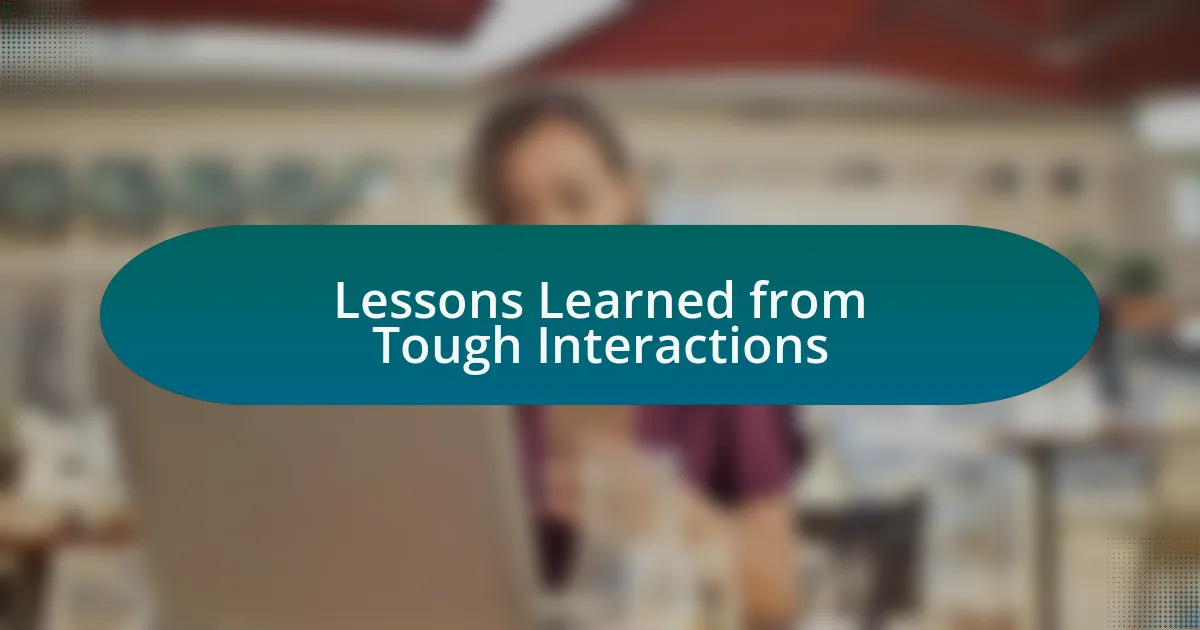
Lessons Learned from Tough Interactions
Another lesson I learned came from a situation where an attendee felt sidelined during a workshop. Their angry feedback caught everyone off guard, but instead of reacting defensively, I paused to ask them what they felt could be improved. This simple question shifted the energy from confrontation to collaboration, reminding me that sometimes, giving others a platform to voice their concerns creates unexpected opportunities for connection. Have you noticed how facilitating a dialogue can lead to solutions we never anticipated?
I also recall an experience at a networking event where a participant monopolized the conversation, leaving others visibly uncomfortable. Instead of allowing frustration to build, I intervened by thanking them for their insights and inviting quieter attendees to share their thoughts. This not only encouraged a broader discussion but illuminated the importance of fostering inclusivity in conversations. It got me thinking—how often do we overlook the voices of those around us in the rush to keep things flowing?
One of the most challenging interactions involved someone who flatly disagreed with a strategic direction we were presenting. Instead of brushing off their dissent, I invited them to share their perspective more fully. This not only deepened the discussion but also reinforced the idea that embracing differing opinions can often lead to richer outcomes. Isn’t it incredible how a willingness to listen can transform conflict into constructive dialogue?
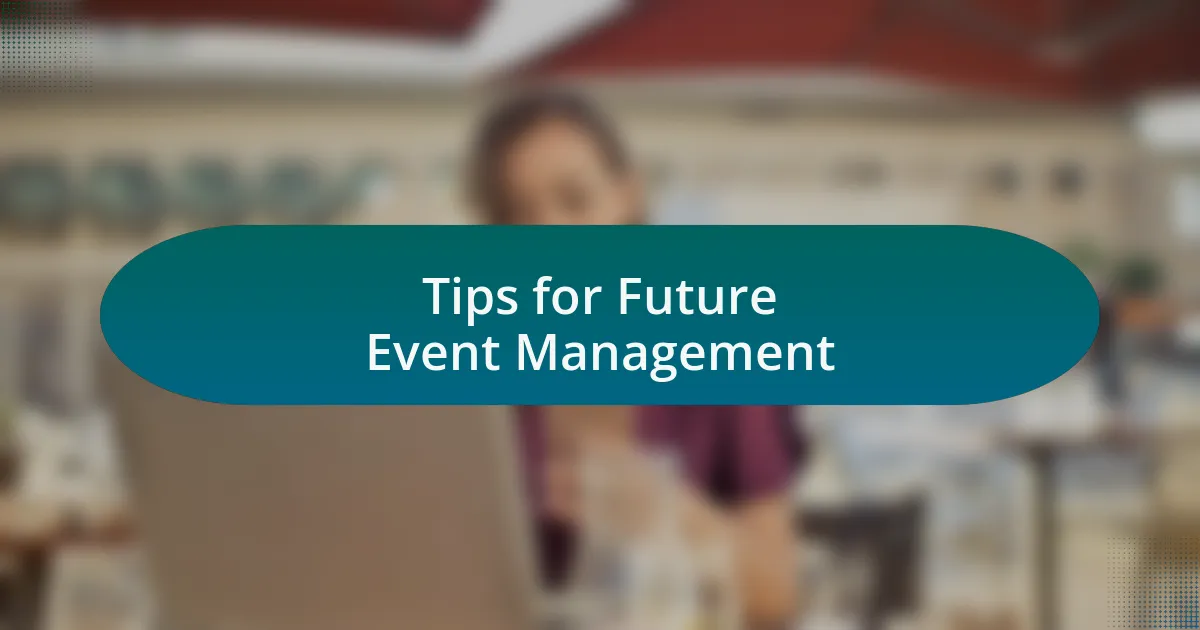
Tips for Future Event Management
When planning future events, consider implementing a clear set of communication guidelines from the outset. I remember a time when unclear expectations led to confusion among attendees, resulting in a few tense moments during the event. By outlining communication protocols, we can avoid misinterpretations and help everyone feel more comfortable engaging with each other.
I’ve found that proactive engagement can be a game-changer in managing challenging situations. At one event, I took the initiative to send out pre-event surveys to understand attendee expectations. The feedback not only shaped the agenda but also made participants feel valued from the start. Isn’t it fascinating how a little foresight can drastically enhance the overall atmosphere?
Lastly, I strongly recommend investing in trained facilitators who can navigate tricky conversations. During a panel discussion, a moderator’s skillful handling of an unexpected outburst prevented a potential uproar. This experience taught me that having a professional managing sensitive dynamics reinforces a respectful and productive environment. How often do we underestimate the power of a well-trained facilitator in steering discussions effectively?